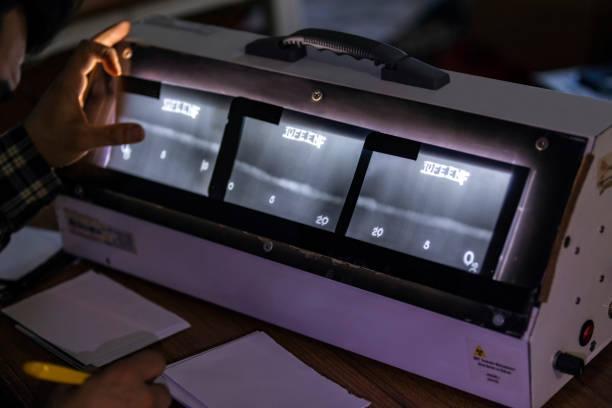Table Of Contents
- Evolution of Digital Radiographic Image Interpretation
- Human Limitations in Radiographic Interpretation
- AI’s Role in Enhancing Digital Radiographic Interpretation
- Image Processing and Feature Extraction in AI-Driven Interpretation
- AI Algorithms for Defect Detection
- Challenges in Implementing AI in Radiographic Interpretation
- Practical Applications in Digital Radiographic Interpretation
- Future Trends in AI-Driven NDT
- Conclusion
- FAQs
Digital Radiography (DR) is a sophisticated version of radiographic testing (RT) that involves the use of digital detectors as an alternative to the conventional films to record high-resolution X-ray or gamma-ray imaging to perform non-destructive testing (NDT). These computer-based systems can provide real-time image capture, processing, and assessment and have better contrast, dynamic range, and storage efficiency than with film radiography. Nonetheless, the visual fatigue, cognitive bias, and subjective judgment may affect the interpretation of the digital radiographs relying on human expertise. Artificial Intelligence (AI) has come to the rescue of these limitations, as a revolutionary digitized radiograph interpretation tool, with machine learning, deep learning, and computer vision algorithms, to automate and increase the accuracy of defect detection and faster processing.
Radiographic interpretation, which is an AI-based interpretation mechanism, uses Convolutional Neural Networks (CNNs) and pattern recognition algorithms to detect subtle discontinuities, including cracks, porosity, inclusions, and absence of fusion, which would otherwise be imperceptible to human eyes. These models are trained on large volumes of annotated radiographic images, which enhances their ability of differentiating between true defects and artifacts besides maintaining consistency and standardization in the judgments. Since industries are shifting towards NDT 4.0 and predictive maintenance, AI in radiography does not only improve reliability and safety but also allows making decisions based on data and real-time analysis of inspection.
This paper presents the detailed discussion of the redefinition of digital radiographic tests in NDT by Artificial Intelligence. The readers will get to know how the traditional film-based processes evolved into AI-integrated digital systems, what limitations people made in the way of interpreting the results, how the AI overcomes them, what algorithm processes pictures and eliminates flaws, and what are the real applications of AI within the radiographic analysis process, obstacles, and the future perspectives of AI in assisting radiologists. You will have a clear picture of how the radiographic inspection world is being transformed by AI, enhancing its accuracy, efficiency, and standardization in the most crucial industries
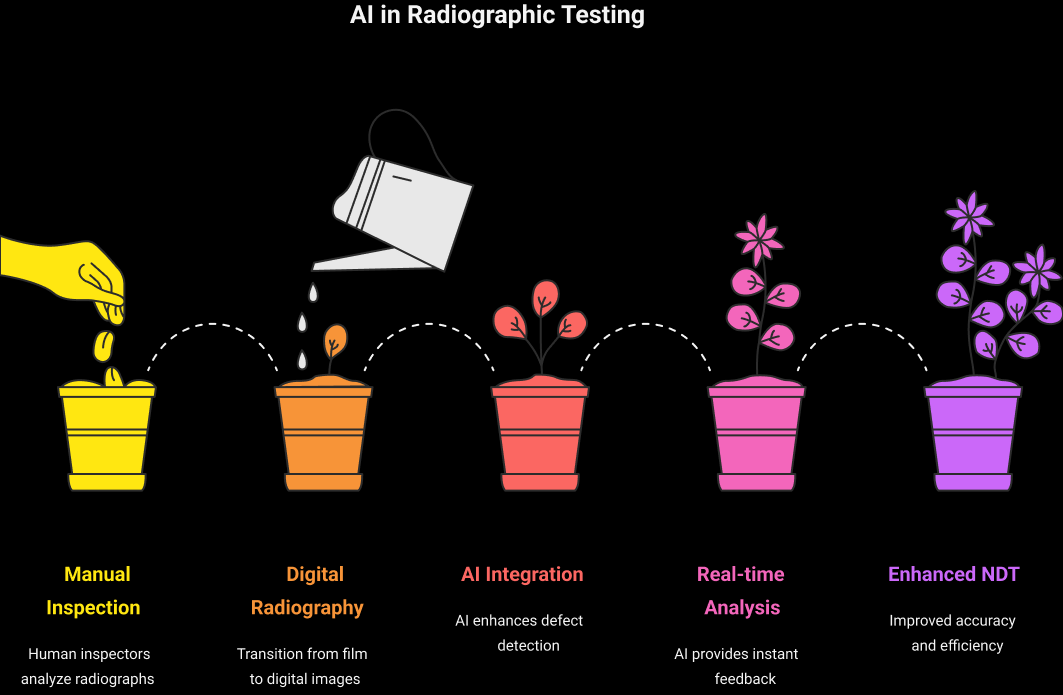
1. Evolution of Digital Radiographic Image Interpretation
Digital radiography has undergone a lot of changes since the time when active inspection was conducted on an analog film, which was widely used in NDT as long as the 20th century. Manual movie-reviewing was time consuming, prone to human errors and could not be automated. The development of computed radiography (CR) and the digital detectors in the 1980s was a turning point, since they facilitated the possibility of digital image processing and further formed the basis of automated defect recognition (ADR). First-generation ADR systems in the 1990s were rule-based systems with classical image processing techniques to detect defects, such as porosity or cracks, in high-volume applications, including automotive castings. These systems increased throughput and were limited by their rigidity requiring a lot of manual adjustments.
The past decade has seen the emergence of machine learning, and deep learning, which has driven the growth in the development of digital radiography. In contrast to rule-based systems, AI-driven ADR learns the behavior directly based on data, and adapts to defect variability and the imaging conditions. CNNs, such as, are good at inferring complex patterns in X-ray images, with high segmentation accuracy. This development is of special significance in safety-sensitive domains such as aerospace and oil & gas, where AI can help inspectors by transferring mundane supervision onto an automated form and improving the ability to detect minute imperfections. Digital radiography has been essential to modern NDT as the process of manual to AI-aided interpretation speeds and increases the accuracy of inspections.
2. Human Limitations in Radiographic Interpretation
NDT interpretation of images with radiography is highly specialized and needs trained and skilled personnel. Human reviewers encounter a number of issues that can undermine precision:
- Omission Errors: The inspector might miss the defects or could not concentrate in areas which are important in order to identify them properly. Studies indicate that the search errors (inability to find defect positions), the recognition errors (inability to classify defects as significant), and the decision-making errors (mis-classification of defects as artifacts) are prevalent.
- Attention and Perception: Human visual system captures only a part of an image and this resulted in inattentional blindness, where anyway apparent error is unseen unless searched out.
- Cognitive Biases: Anchoring bias refers to inspectors being fixed on their initial viewpoints, whereas availability bias means that inspector pays attention to defect types that they last came across with, and may overlook rare defects.
- Fatigue and Workload: Faltering accuracy as a result of long inspection periods causes high incidences of false positives and false negatives. The intense workloads and time allowances generate hasty assessments, whereas the other factors such as interruptions do increase error intensities.
These shortcomings present the prospect of AI supplementing human potential, leading to optimal in-depth and error-free analysis in the inspection processes of NDT.
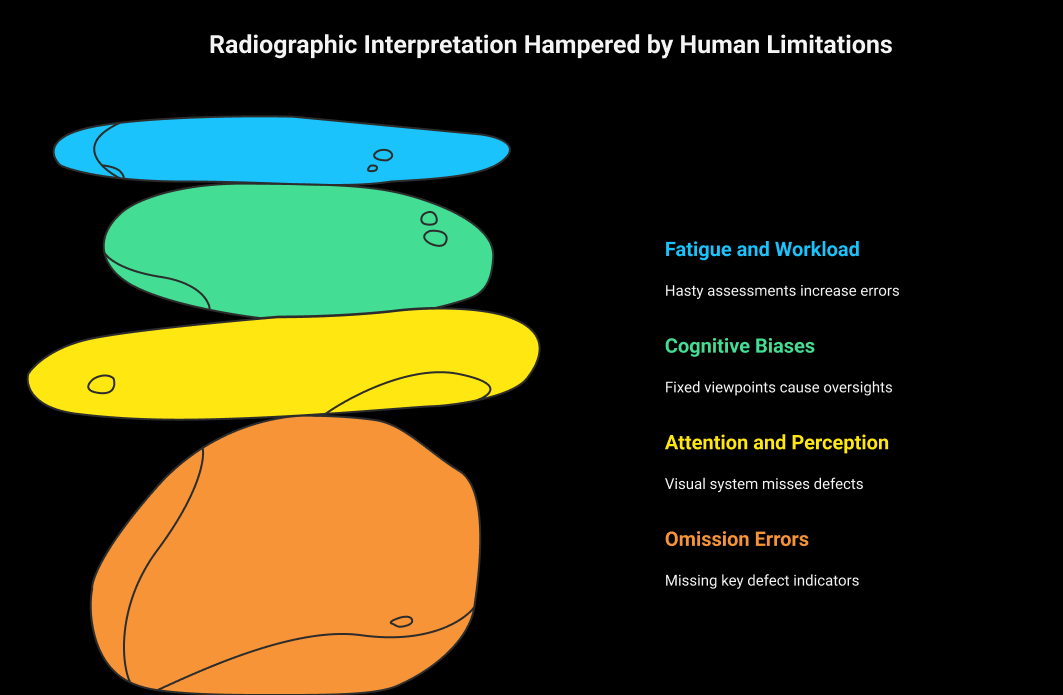
3. AI’s Role in Enhancing Digital Radiographic Interpretation
AI automatically enhances digital radiograph interpretation accuracy and efficiency in NDT. Main advantages are:
- Increased Detection Accuracy: Deep learning models, specifically CNNs, are more likely than human inspectors to spot faint or minor defects some of which include micro-cracks, porosity or inclusion that may not be detected by human inspectors under pressure of time. Applications in aerospace include technical inspection of turbine blades or airframe composites where AI finds discontinuities without the overhead and cost of numerous inspectors.
- Speed and Productivity: AI-based process automates the outcome of radiograph analysis and processes thousands of images in minutes, which is important in such high output-oriented industries as automotive manufacturing. This lessens check outs and can provide real-time feedback to adapt the parameters of production.
- Consistency and Standardization: AI has consistent and standard results unlike human beings who have varying results across shifts due to performance, fatigue and bias. It is also helpful in unifying reviews; less-skilled inspectors can use it to enhance their reviewing skills.
- Defect Classification and Insights: AI can classify different defects (e.g., lack of fusion, slag inclusions) and generate data-driven insights on making process improvements. As an example, weld inspection uses the patterns that AI detects to determine changes to welding parameters.
In use cases of NDT, AI-powered systems can minimize the cost of reWorkspace and scrap rates. They combine with computed tomography (CT) to have a more detailed 3D context and provide support for predictive maintenance by monitoring the trend of the defects over time.
4. Image Processing and Feature Extraction in AI-Driven Interpretation
In NDT, radiographic images are usually subject to low contrast, noise, and uneven distribution of the grayscale, hiding defects. Image Processing and feature extraction via AI pipelines helps increase the visibility of defects and can analyse the results:
- Image Processing Techniques: Histogram equalization facilitates moving of pixel values with an intention of enhancing contrast and the median filter eliminates noise but does not blur edges. Wavelet transforms are used to break an image into frequency elements to selectively remove noise, and a complex fault-background can be segmented through adaptive thresholding. Morphological interactions improve defect geometry by filling the holes in porosity nature.
- Feature Extraction: Features based on the intensity (i.e. mean, standard deviation) reflect grayscale variations whereas features based on the spatial dimensions evaluate the coherence and smoothness. Normative results such as entropy quantify the randomness of textures de-prioritizing defects and artifacts. Sobel or Canny operator edge-based features identify cracks and classifications are based on geometric (e.g., area, perimeter, etc.) measures of defect shapes.
- Dimension Reduction: Methods such as the principal component analysis (PCA) simplify feature sets, significantly decreasing the computational burden, but not at the expense of necessary information.
Such processed attributes are available to AI models to allow accurate defect detection. For example, CNNs automate the extraction of features based on convolutional layers, and learn hierarchical representations that are directly applicable to raw images and are efficient especially during complex weld inspections.
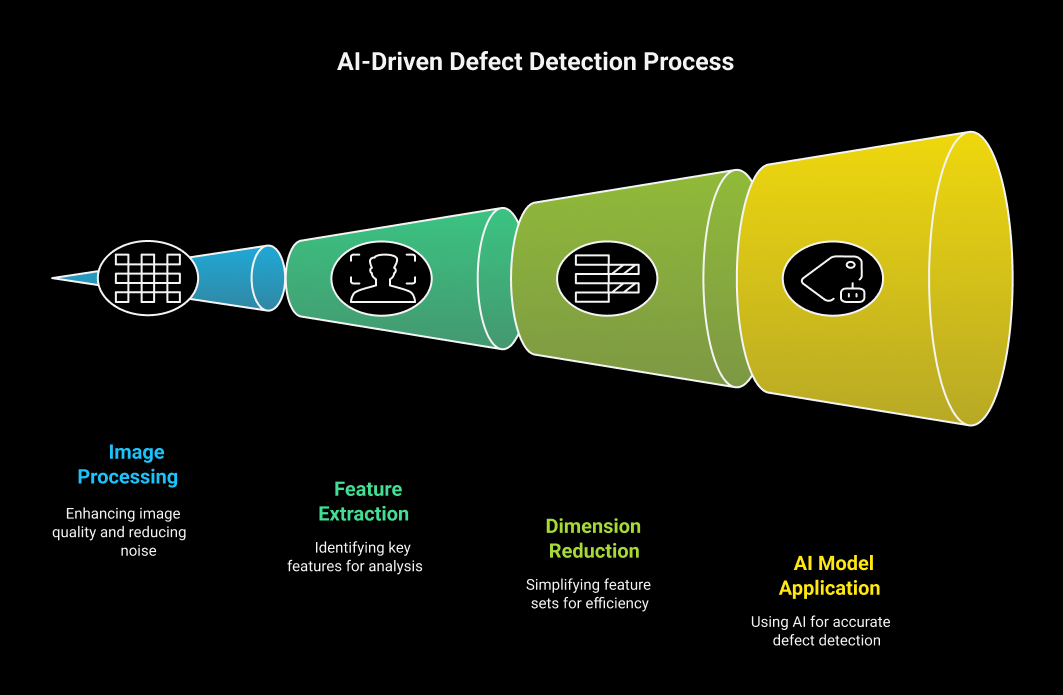
5. AI Algorithms for Defect Detection
In automated radiographic interpretation of NDT, AI algorithms lie at the heart of the directive:
- Machine Learning: Support Vector Machines (SVMs) are best to use when there are only two classes of patterns to distinguish an identifiable defect or non-defect in a balanced data set. K-Nearest Neighbors (KNN) deal with multi-class, e.g. labeling porosity versus inclusions.
- Ensemble Methods: With very unbalanced datasets (the most defective items are scarce), the random forests, and gradient boosting are the ensemble methods combining numerous separate models in one to achieve better generalization.
- Deep Learning: CNNs reach an accuracy level of more than 95% in defect segmentation, and architectures such as U-Net separate the defect by identifying its boundaries to estimate its size. The pre-trained models such as ResNet decrease the data needs in the event of transfer learning. Mask R-CNN offers pixel-level categorizing of defects to determine the exact measure of the defects.
- Emerging Model: A UI used in exploration of the large language models in multimodal use, to produce narrative defect descriptions in order to improve reporting.
Multi-scale extraction through pyramid networks is used to detect the varying-size defects, and instance segmentation is used to specify the accurate localization. The algorithms allow professionals who work in NDT to automate routine tasks and devote their attention to the essential decision-making process.
6. Challenges in Implementing AI in Radiographic Interpretation
In spite of the promise AI holds, there are a number of challenges to the introduction of AI in NDT radiographic interpretation:
- Lack of Data: Industrial defect data is frequently proprietary, and some defect types do not occur frequently which limits the amount of data available to train robust AI models that could promote defect detection in the needed areas. This is addressed at least partially by synthetic data generation through simulations (e.g., Monte Carlo based X-ray modeling), although gaps in domain between synthetics and real images remain.
- Model Generalization: The models are likely to be unable to make predictions on other materials (e.g. steel welds) after being trained on certain other ones (e.g. aluminum castings), owing to differences in imaging-type or defect-type. It is important to keep the parameters of the imaging consistent or to perform preprocessing.
- Interpretability: Black-box based AI models increase the distrust that NDT professionals have. They require explainable AI that features that influence decision-making using the information.
- Workflow Integration: AI solutions will be required to integrate into legacy workflows, workflows that may include legacy equipment and software.
- Regulatory Compliance: Compliances such as ASME and ASTM require individuals that undergo certification duties on radiographic analysis. The qualification of AI systems requires demonstrating the performance thresholds (e.g., the probability of detection, the false call rate), which may necessitate the presence of humans. There would be the issue of liability when it comes to AI missing out on the crucial defects and it would need conservative deployment.
- Information Privacy and protection: Radiographic data collected and stored is sensitive information and thus privacy and protection is a consideration especially with aerospace or defence applications.
The liaising between AI developers and NDT professionals, and stakeholders in the industry is paramount to surmount these challenges to achieve reliable and compliant AI implementation.
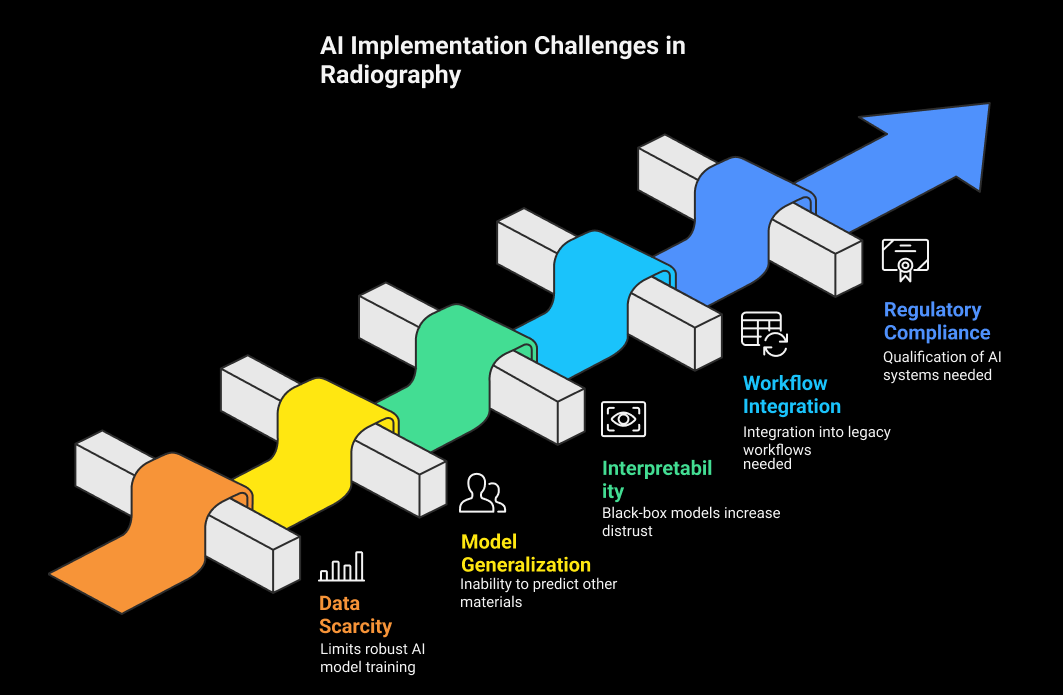
7. Practical Applications in Digital Radiographic Interpretation
Digital radiography by AI is revolutionizing NDT in all sectors:
- Automotive: AI checks castings on engines, the welds, identifying porosities and cracks to minimise scrap and assure safety. Plants with high-volume production lines are automated, which enhances throughput.
- AI inspection: AI inspection of turbine blades, airframes, and laser welds match high standards of quality. False calls are reduced since multi-models reduce uncertainty and only reliable causes are called.
- Oil & Gas: AI is able to examine girth welds in pipelines, stopping leaks and checking against environmental controls. The maintenance is assisted by real-time inspection in harsh conditions.
- Energy: The AI has the ability to detect breaks in boiler pipes and casting turbines and enhance the reliability of power plants.
- Marine and Rail: The AI checks the hull welds and rail parts, and the partial safety and integrity of the entire structure.
Cloud computing allows remote diagnosis and robotics incorporates AI into on-line tools to achieve real-time corrections to processes, consistent with NDT 4.0.
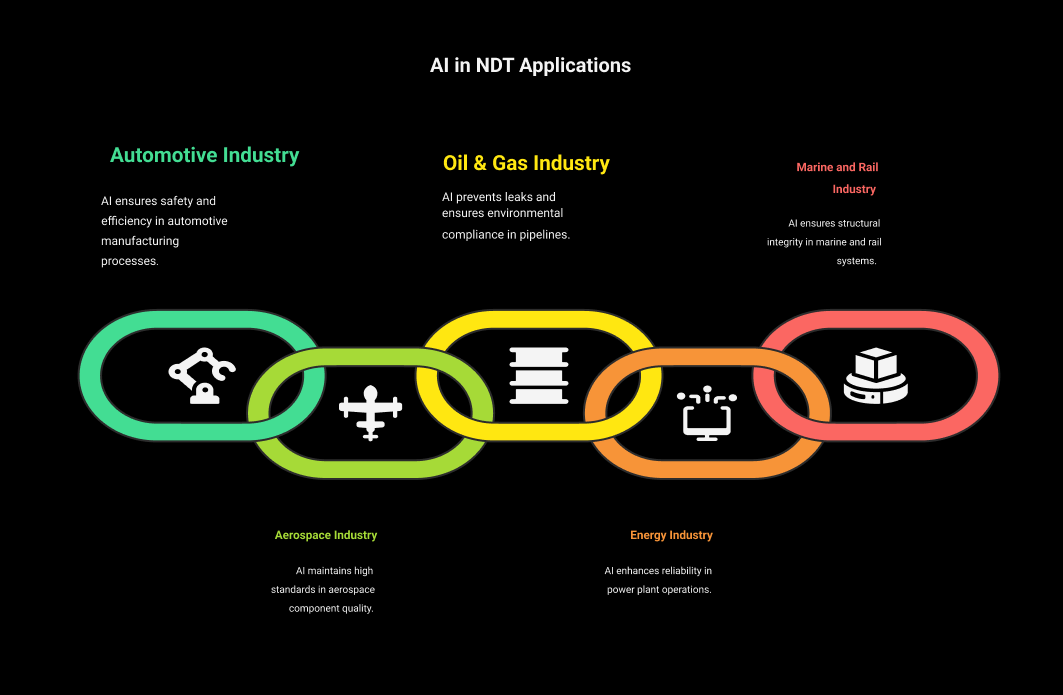
8. Future Trends in AI-Driven NDT
The perspective of AI in NDT, specifically, of digital radiography, is bright:
- Predictive Analytics: AI will monitor defect trends to forecast process drifts or equipment wear and turn NDT into a preventive maintenance process. As an illustration, studying the patterns of weld defects will lead to the proactive changes in welding machines.
- Elaborated algorithms: New models such as transformers will represent image details more accurately and unsupervised anomaly detection will detect new defects without annotated data.
- Explainable AI: AI-based systems will be designed in the future to contain explanation modules, where systems illustrate decision-making, it can build more trust and allow refinement.
- Data-Centric Development: The focus on curated datasets and synthetic data generation and domain adaptation will enhance model robustness. Digital twins will be used to simulate realistic radiographs to span rare situations.
- Standardization and Adoption: Organizations such as ASTM and ISO are creating standards to qualify AI and defining performance thresholds as well as human-in-the-loop needs. This will spur the wider use in industries.
- Labor Evolution: AI supervision training will become part of NDT certifications and prepare an inspector to work with intelligent systems.
These trends are consistent with Industry 4.0, where NDT becomes part of interconnected manufacturing environments to achieve quality control and optimization on a real-time basis.
Conclusion
It is making a breakthrough in non-destructive testing by changing the interpretation of digital radiographic images. Through AI, defect detection accuracy is optimized, and inspection is accelerated, additionally, it offers data-backed insights about how to optimize the process. NDT and automotive sectors are good examples of the use of AI in the assessment of the functional condition of metals, which guarantees higher quality and safety requirements, minimizing costs and making predictive maintenance possible. Artificial intelligence has limitations such as limited data availability, regulatory compliances, and explainability, although the problem is being solved by the increased statistical power algorithms, data creation, and standardization. The upcoming development of AI will increase the capabilities of NDT specialists and serve as an impetus to innovation and quality control stability in industry.
FAQs
1. Is radiography a non-destructive testing?
Yes, radiography is a non-destructive testing (NDT) method. It checks materials for internal defects using radiation, such as gamma or X-rays, without harming the thing being inspected.
2. How is AI used in radiography?
AI is revolutionizing radiology through better patient care, streamlined workflows, and enhanced image analysis. Deep learning AI systems in particular are capable of improving image quality, automating processes like measuring and segmentation, and detecting minute irregularities. By concentrating on challenging situations, radiologists may be able to diagnose patients more quickly and produce better results.
3. What are the non-interpretive uses of AI in radiology about?
In radiology, non-interpretive applications of AI concentrate on streamlining procedures, workflow, and efficiency within a radiology department rather than directly assisting with medical image interpretation. Streamlining invoicing, improving picture quality, scheduling patients, and optimizing scan protocols are some of these uses. In essence, they optimize procedures and better distribute resources, which eventually improves operational results and patient care.
4. How accurate is AI radiology?
AI in radiology shows great accuracy, frequently matching or surpassing human radiologists in certain tasks, such as identifying particular abnormalities. AI can dramatically lower false-negative results, boost sensitivity, and enhance reading efficiency, according to studies. However, accuracy differs based on the particular task, AI model, and training data.
5. What are the disadvantages of AI in radiology?
AI algorithms can be complex and difficult to interpret, making it challenging to understand how they arrive at their decisions.
